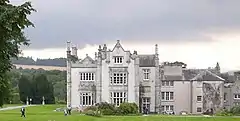Killruddery House
Killruddery House is a large country house on the southern outskirts of Bray in County Wicklow, Ireland, approximately 20 km south of Dublin.[1] The present structure is a south facing multi-bay mansion, originally dating from the 17th century, but remodelled and extended in 1820 in the Elizabethan style. It is constructed as variously single, two, three and four storeys in the shape of an irregular quadrangle enclosing a courtyard. To the north an office wing incorporates the 17th-century portion and to the south and west is a large domed conservatory. The house sits within a large landscaped demesne which features a pair of long parallel canals in front of the house.[2]
| Killruddery House | |
|---|---|
 Killruddery House | |
 Location of Killruddery House in Ireland | |
| General information | |
| Address | Southern Cross |
| Town or city | Bray, County Wicklow |
| Country | Ireland |
| Coordinates | 53.1816°N 6.1020°W |
| Opened | 17th century |
| Grounds | 3,237,300 square metres (800.0 acres) |
| Website | |
| www | |

History
In 1534, Sir William Brabazon of Leicestershire was posted to Ireland to serve as Vice-Treasurer. Later, in 1539, after vigorously supporting King Henry VIII's efforts to break with Rome and the Dissolution of the Monasteries, Sir William secured ownership of the Abbey of St. Thomas, Dublin, whose lands included Killruddery. In 1627 his great-grandson, also William Brabazon (c.1580-1651), was made the 1st Earl of Meath. The 2nd Earl of Meath (1610–1675) built a new house at Killruddery in 1651 to replace one burned down in the civil war six years earlier. Contemporary pictures show an East-facing building of five bays.[3]
The 10th Earl of Meath carried out an extensive reconstruction of the house between 1820 and 1830. Architects Sir Richard Morrison and his son William Vitruvius Morrison were commissioned to build a Tudor Revival mansion incorporating the original 17th century mansion. The result was a large building, featuring a North-facing entrance with a cupola, behind which clustered a number of wings forming an irregular quadrangle around a central courtyard. The interior of the house originally featured elaborate chimney-pieces by Giacinto Micali, crimson silk damask from Spitalfields, stained glass by John Milner, a domed ceiling by Henry Popje and a drawing room ceiling by Simon Gilligan. A clock tower in the forecourt houses a water clock designed and constructed by The 13th Earl of Meath with a pendulum powered by a jet of water.[4]
Along with other sections of the house, the original grand entrance and dome was demolished in the 1950s,[5] and the house was remodeled by Claud Phillimore (who later succeeded, in 1990, as The 4th Baron Phillimore).
Currently the estate extends to 800 acres and is owned by the 15th Earl and Countess of Meath. It is used primarily as a country house, garden and farm.[6] The estate has been used as a filming location for a number of movies and TV mini-series including My Left Foot, Far and Away, Angela's Ashes, Camelot and The Tudors.[4][7] Into the Badlands, The Turning, and Fate: The Winx Saga were also partially filmed there. Killruddery's gardens are also home to the annual Groove Festival.[8]
References
- Record at the National Inventory of Architectural Heritage of Ireland
- "Kilruddery House, Bray, Co. Wicklow". Ask About Ireland. Archived from the original on 18 February 2013. Retrieved 17 November 2012.
- "Kilruddery-A Place to Escape". Retrieved 17 November 2012.
- "Kilruddery - The House". Killruddery.com. Archived from the original on 13 April 2016.
- "1820 – Killruddery, Bray, Co. Wicklow". Archiseek.com. 2010. Retrieved 9 May 2018.
- "Killruddery House Gardens". DiscoverIreland.ie. Retrieved 9 May 2018.
- "Heirs and graces: Peek inside the magnificent Killruddery House". Independent News & Media. 8 August 2016. Retrieved 9 May 2018.
- "Groove festival website". Retrieved 9 May 2018.
